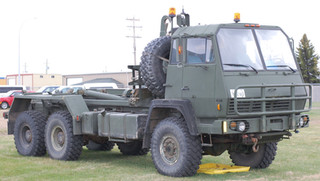42 Radar Squadron In Vermilion
- Vermilion Voice
- May 22, 2019
- 4 min read

Back row from left, Sgt Mick Albert, Cpl Erick Steeves, and Lt Tae Wan Kim. Front row, Sgt Filiatreault. Photos Angela Mouly
The Royal Canadian Air Force’s 42 Radar Squadron based out of Cold Lake deployed approximately 30 personnel to Vermilion from May 2 - 28. Two locations were set up including an operations site and a radar site, both manned 24/7 with personnel working 8 - 12 hour shifts in collaboration with Exercise Maple Resolve which was scheduled from May 11 - 25. 42 Radar Squadron is one of two deployable radar squadrons in Canada, and Maple Resolve involved American, British, French, and Canadian troops working together including over 5,000 people. Sgt Filiatreault explained that they are an operational training unit who were providing radio capability, satellite mission control, and overseeing quite a lot of electronics. Lt Liebrecht said that with a small group, everyone is specialized to do a lot of different things. “Since we are a NATO country we have to be familiar with a lot of different types of kits and equipment,” said Lt Liebrecht. 42 Radar Squadron used radar that can steer the beam electronically and can see 240 nautical miles or approximately 400 km. A third party from Ottawa tested the safety ranges of radiation from the radar prior to exercises and onlookers stood within a safe zone of radiation. “Civilian safety is number one for us,” said Lt Tae Wan Kim.

The SSR atop the ASR at the radar site in Vermilion on May 15.
“We provide surveillance of the airspace in support of Exercise Maple Resolve which is a large primarily army, but joint exercise out of the Wainwright Training Area. The Air Force integrates by providing both rotary aviation (helicopters) and close air support (Alpha jets and CF-18s), but no aircraft landed in Vermilion due to the runway. Maple Resolve Exercise is a simulated war determining how ground forces would react. We provide a common operating picture and control the airplanes going into that exercise area. The aircraft are then handed off to controllers (people on the ground). Our squadron mandate is validated by making sure our equipment and personnel are ready to be deployed in response to any Government of Canada initiatives which could include anything from protecting a coastline to overseas operations,” said MWO Carlisle Mason. 42 Radar Squadron’s call sign is ‘Trapline’; and also participating was United States Air Force exchange officer, Capt Heyne, who was the Detachment Commanding Officer. Lt Liebrecht was trained in Cornwall, Ontario in 2017 and said joining the Air Force was the best decision he’s made. After monitoring Wainwright airspace, and facilitating the air battle he said, “We’re here just to make sure that everyone gets home safe.” MWO Mason continued to describe that the operations site housed both an Operations MECC (mobile environmentally controlled container) and a Welcome MECC. The Welcome MECC was used as a nice place to get out of the elements and discuss lessons learned etc. This year, they tried using new microwaves to feed their information and in addition had radio antennas from their operations MECC.
They ran one from the airport building, but provided four additional phone lines; and used a satellite and a satellite communications trailer to transmit information. With personnel working around the clock, they used a light trailer to illuminate the area. They also had a refrigeration mechanical trailer, and a generator with a berm around for environmental concerns (in the event of a spill). The berm had a water filtration system that could filter out contaminates and keep from overflowing. Their TFAR (trailer forward area refueling) got refuelled from Lloydminster every few days, and their RM truck with a slip tank was used to deliver fuel from site to site. This year, 42 Radar Squadron was thrilled to be able to use 4Wing Cold Lake’s deployable fitness centre. Using brand new equipment for a new initiative, personnel enjoyed the opportunity to keep fit. It was the first time they have had such equipment and did not feel lacking during exercises.

From left, Lt Tae Wan Kim, Sgt Mick Albert, and Sgt Josh Filiatreault using the new deployable fitness centre.
He went on to describe how they use safety with fire stations and how MECCs are packed up to go. Their communications equipment was on an A-frame that fits on a PLS (pallet loading system). A large hook on a hydraulic system is designed to guide and load H-frames or A-frames onto the trucks. They used a HLVW (heavy logistics vehicle wheeled), and an HESV (heavy equipment service vehicle) which is more robust than the HLVW, each with trailers to haul behind.“Everything is designed to be both road and air transportable. Things have been going well for us; operationally it’s been a success so far,” said MWO Mason.
(L) a HESV; (M) A MECC (mobile environmentally controlled container) that can compacted to fit on a truck; (R) a HLVW.
During a tour of the sites given to local flying club members, Lt Tae Wan Kim said, “Thanks for taking the time to show interest in what we do and support the troops.” “It’s an amazing facility; to think that this can all be transported in 72 hours,” said Vermilion River Flying Club member Larry Bingham.
School students also had the opportunity to tour the sites the following week. “Overall, I found that the townspeople in Vermilion have been so nice. Usually we are in a field setting and not within a community. We are very appreciative that everyone was very welcoming which allowed for a good experience,” said MWO Mason.
“A lot of people shook our hands and thanked us for our service,” added Sgt Filiatreault.

From left, Cpl Phinney, Capt Heyne, Lt Kim, Lt Liebrecht, MCpl Goosen, Cpl Hodgson, and MWO Mason.










Comments